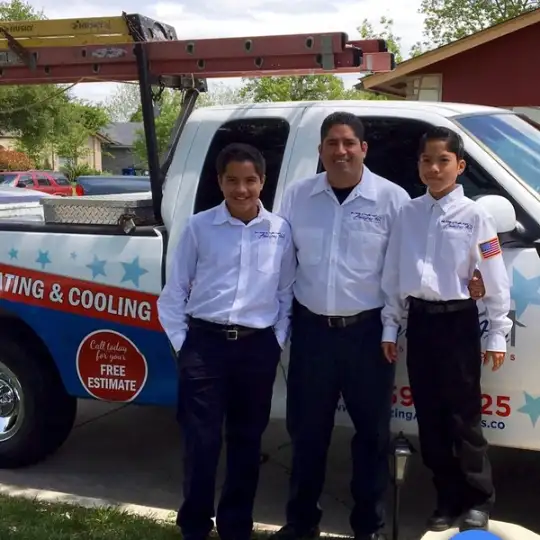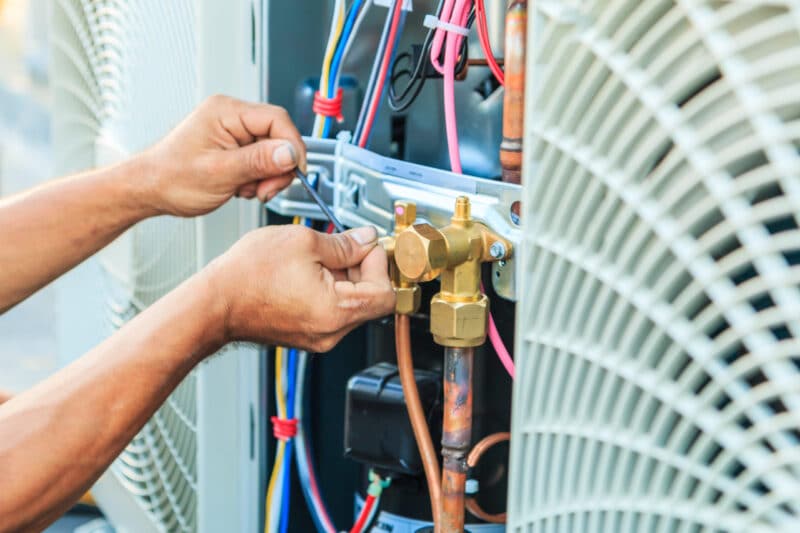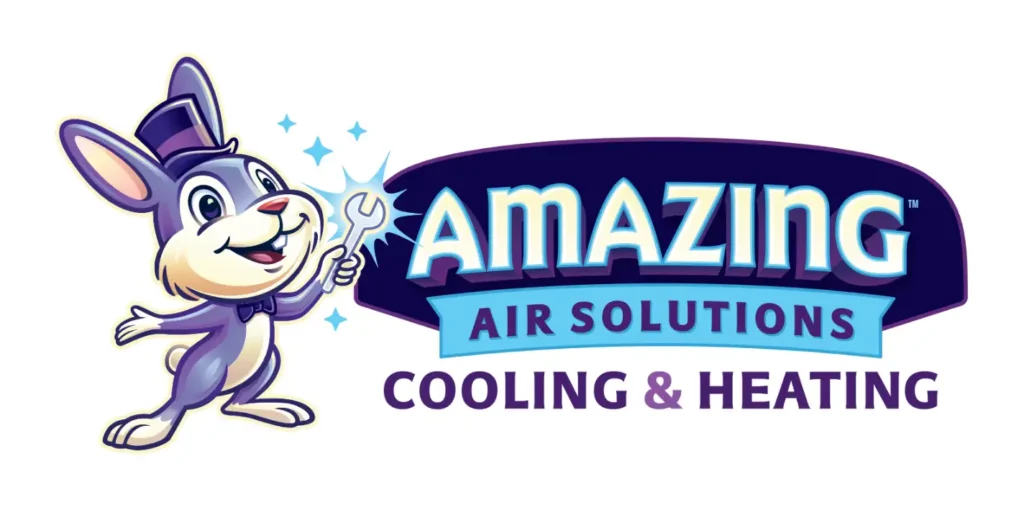
Need a reliable San Antonio AC and heating company to handle your cooling and heating needs? Reach out Amazing Air Solutions’s skilled team today and see why we’re one of the most trusted names in the area for exceptional service!
What you get from Amazing Air Solutions:
Don't wait until your A/C goes out on a hot summer day! Call us today to schedule your maintenance appointment
Providing routine maintenance on your cooling unit is essential for keeping your system running efficiently, extending its lifespan, and ensuring your home stays cool and comfortable. It’s a proactive measure that can save you money, improve indoor air quality, and reduce the likelihood of unexpected breakdowns.
Getting regular maintenance for your air conditioning (A/C) system is important for several reasons including:
Regular maintenance helps ensure that your A/C system operates at its peak efficiency. When your A/C is running efficiently, it consumes less energy, which can lead to lower utility bills.
Air conditioning maintenance can prolong the life of your system. When your A/C is well-maintained, it’s less likely to experience major breakdowns or failures, which can save you money on costly repairs or premature replacements.
Routine maintenance helps keep your cooling system’s components clean and in good working condition. This ensures that your A/C can effectively cool your home, providing consistent comfort throughout the hot summer months.
A well-maintained A/C system can help improve indoor air quality by removing dust, pollen, and other allergens from the air. Clean filters and coils prevent these particles from being circulated throughout your home.
Regular maintenance can catch minor issues before they escalate into major problems. This can save you money on unexpected and costly A/C repairs.
Maintenance appointments often involve inspections to identify potential issues early. Technicians can recommend necessary repairs or adjustments to prevent breakdowns during the peak cooling season.
Some A/C manufacturers require regular maintenance to keep your warranty valid. Skipping maintenance may void your warranty, leaving you responsible for any repair or replacement costs.
A well-maintained cooling unit operates quietly and reliably, providing you with consistent comfort and peace of mind.
Central AC systems provide consistent cooling throughout your home, eliminating hot spots or uneven cooling that can occur with window units.
An efficient A/C system consumes less energy, which reduces your carbon footprint and helps protect the environment.
While A/C maintenance does come with a cost, the potential savings in energy bills, repairs, and replacements over time can outweigh the initial investment.

No matter the situation, our China Grove, TX professional HVAC technicians will work to determine the best plan of action for installing a new air conditioning system in your home or business. From there, we will review the recommendations with you in detail, so you will know exactly what solution is best for your cooling needs before any work is done.
Amazing Air Solutions offers a full line of installation, maintenance, and repair that your cooling system may require. You can count on our trusted professionals for exceptional service and quality craftsmanship. Amazing Air Solutions is proudly and professionally serving the greater China Grove, TX area.

Air conditioning system maintenance is essential to ensure your unit operates efficiently, extends its lifespan, maintains indoor air quality, and reduces energy consumption.
It’s recommended to have your cooling system serviced at least once a year, preferably in the spring before the cooling season begins.
While there are some maintenance tasks you can do, like changing the air filter, it’s generally advisable to have a professional technician perform a comprehensive maintenance check to avoid potential problems and to ensure peace of mind.
A/C maintenance typically includes cleaning the coils, checking refrigerant levels, inspecting electrical components, lubricating moving parts, tightening connections, and calibrating thermostats.
Common signs include reduced cooling efficiency, strange noises, unusual odors, frequent cycling, and increased energy bills.
You can improve A/C efficiency by keeping your system’s air filter clean, sealing duct leaks, maintaining proper insulation, and using a programmable thermostat.

Air conditioning systems are essential for maintaining a comfortable indoor environment, especially during the warmer months. However, like any other home appliance, they have a finite lifespan. Recognizing the warning signs that your air conditioning unit may need to be replaced can save you from unexpected breakdowns and costly repairs.
One of the most noticeable signs of an aging or failing air conditioner is its inability to cool your home effectively.
– Compressor inefficiency
– Refrigerant leaks
– Worn-out components
Pay close attention to whether these issues persist even after routine maintenance.
If your energy bills have significantly increased without changes in usage patterns, this could indicate that your AC unit is operating inefficiently due to aging parts or outdated technology. Older units often work harder to produce the same level of cooling as newer, energy-efficient models.
Month | Year 1 Energy Cost | Year 2 Energy Cost | Percentage Increase |
July | $120 | $150 | +25% |
August | $125 | $160 | +28% |
If costs continue rising despite regular servicing, it might be time to upgrade.
When repair costs begin piling up, replacing your system may make more financial sense than continuing with temporary fixes.
– If repair expenses exceed 50% of the cost of a new unit, replacement is likely more cost-effective.
– Chronically recurring issues such as refrigerant leaks or motor failures can signify systemic problems that can’t be resolved by repairs alone.
Unusual sounds such as grinding, banging, or squealing might indicate internal mechanical damage within the AC unit (e. g. , failing motors or loose belts).
– Mold growth within ducts
– Electrical malfunctions or overheating
These warning signs often require immediate attention and should not be ignored.
The typical lifespan of an air conditioning unit ranges from 10–15 years, depending on usage and maintenance frequency. If your system has surpassed this window and frequently shows performance issues, investing in a modern replacement could offer significant benefits such as improved energy efficiency and enhanced cooling capabilities.
Key factors contributing to reduced lifespan include:
– Poor installation practices at outset
– Lack of routine maintenance over time
Delaying replacement can lead to:
1. Increased discomfort during peak seasons when breakdowns occur unexpectedly. 2. Higher operational costs due to inefficiency. 3. Compromised indoor air quality caused by malfunctions (e. g. , mold growth).
By recognizing these signs early on and consulting with HVAC professionals about potential solutions, you ensure greater comfort while optimizing long-term savings on energy usage and repairs.
Upgrading to an energy-efficient air conditioning (AC) unit offers numerous advantages, from reduced energy bills to a smaller environmental footprint. An energy-efficient system not only enhances comfort but also provides long-term financial and ecological benefits. Below, we explore the key benefits that make upgrading worthwhile.
Energy-efficient air conditioners consume less electricity while maintaining optimal cooling performance. This can significantly reduce monthly utility expenses.
Newer AC units are designed to provide consistent and even cooling throughout your home. Features like multi-zone cooling allow you to control temperatures in specific areas, ensuring maximum comfort without overcooling or wasting energy.
Many governments and utility companies offer incentives for upgrading to high-efficiency systems. These can include tax credits, rebates, or discounts on qualifying models, offsetting some of the initial costs associated with purchasing an upgraded unit.
Incentive Type | Potential Savings | Eligibility Criteria |
Federal Tax Credits | Up to $600 for AC units | Must meet specific efficiency standards set by the U.S government. |
Utility Rebates | $100–$500 | Often requires installation by certified professionals. |
Energy-efficient models often come equipped with advanced filtration systems that enhance IAQ by reducing dust, allergens, and pollutants circulating in your home’s air supply.
Some features found in newer units include: – HEPA filters for trapping fine particulates. – Dehumidifiers integrated into the system for improved humidity control. – UV light technology that helps kill airborne bacteria and mold spores.
Modern systems are built using advanced components designed for durability and minimal wear-and-tear during operation: – Fewer Repairs: With inverter technology and enhanced compressors, parts experience less strain.Self-Diagnostic Features: Many units now alert homeowners or technicians about potential issues before they become serious problems.
If you’re unsure whether it’s time to upgrade your current AC unit, here are some indicators: 1. Your unit is more than 10–15 years old. 2. Rising energy bills despite regular maintenance. 3. Frequent breakdowns requiring costly repairs. 4. Uneven cooling or inconsistent airflow throughout your home.
Investing in an energy-efficient air conditioner may seem costly upfront but offers substantial long-term savings and comfort benefits while contributing positively to the environment—making it a decision worth considering carefully when replacing an aging system or building a sustainable future at home.
Upgrading to an energy-efficient air conditioning unit can offer homeowners a wide range of benefits, from reducing energy bills to minimizing environmental impact. Modern energy-efficient models are designed to provide optimal cooling while using significantly less electricity compared to older systems. Below, we explore the key advantages of making this important upgrade.
One of the most immediate and noticeable benefits of upgrading is reduced utility costs. Older air conditioners often lack the advanced technology used in energy-efficient models, leading to higher power consumption.
A small investment in a higher-SEER system can result in significant long-term savings.
By upgrading, you’ll enjoy not only cooler air but also greater flexibility in managing your home’s climate.
Reducing your carbon footprint is another critical advantage of switching to an energy-efficient system.
Feature | Environmental Impact |
Reduced Electricity Use | Less strain on local power grids lowers overall carbon emissions produced during electricity generation. |
Eco-Friendly Refrigerants | Most modern systems use refrigerants like R-410A or R-32, which have lower global warming potential compared to older refrigerants like R-22 (phased out due to its ozone-depleting properties). |
Longer Lifespan | Durable construction means fewer replacements over time, reducing waste sent to landfills. |
Upgrading helps protect natural resources while promoting sustainable living practices.
Including this as part of your home’s infrastructure makes it more marketable in today’s competitive real estate landscape.
By upgrading, you’ll experience efficient cooling without sacrificing peace and quiet inside your home.
Transitioning from an outdated AC unit to an energy-efficient alternative delivers tangible financial savings alongside improved performance and comfort levels at home—all while contributing positively toward environmental sustainability goals over time. Evaluate your current air conditioning system’s efficiency today—it might be time for a beneficial upgrade!
Proper installation of an air conditioning system is a critical factor in achieving optimal performance and energy efficiency. Even the most advanced and high-quality AC units can fail to deliver their promised benefits if not installed correctly. Below, we explore why proper installation is so important and what factors to consider during the process.
Hiring a professional HVAC technician ensures that all aspects of the installation meet industry standards.
Factor | Why It Matters |
System Sizing | An undersized unit will struggle to cool your home, while an oversized unit wastes energy. |
Ductwork Design | Improperly designed ducts can lead to airflow restrictions or leaks that reduce efficiency. |
Refrigerant Levels | Low or excessive refrigerant can damage components or impair cooling performance entirely. |
Placement Location | Installing outdoor units in shaded areas improves efficiency while avoiding potential obstructions. |
Proper air conditioning installation is an investment in long-term comfort and efficiency for your home—one that pays off through reduced energy bills, fewer repairs, and consistent indoor climate control over time.
Proper maintenance and professional servicing are essential steps in prolonging the life of your air conditioning system. A well-maintained AC unit not only ensures optimal performance but also helps avoid costly repairs or premature replacement. Here’s how you can extend the lifespan of your air conditioner with professional servicing and regular care.
Maintenance Task | Frequency | Notes |
Professional inspection | Annually | Ideally before summer starts. |
Air filter replacement/cleaning | Every 1–3 months | More frequent if you have pets or allergies. |
Coil cleaning | Annually | Ensures proper heat absorption/release. |
Ductwork inspection/cleaning | Every 2–3 years | Helps maintain airflow and efficiency. |
By combining these DIY practices with regular professional servicing, you can maximize your HVAC investment’s value while enjoying consistent comfort throughout its lifespan.
Taking care of an air conditioning system requires effort but pays off significantly in reliability, efficiency, and cost savings over time when paired with routine professional assessments.
When it comes to choosing the right air conditioning system for your home, two popular options often stand out: central air systems and ductless mini-splits. Each has distinct advantages, making them suitable for different needs and situations. Understanding the key differences can help you make an informed decision.
Advantages of Central Air Systems: – Uniform Cooling: Distributes cool air consistently across all rooms.Aesthetically Pleasing: The ductwork is hidden behind walls, ceilings, or floors, leaving no visible indoor units.Air Quality Control: Equipped with filters that trap dust, pollen, and other allergens.Integrated Heating Options: Often pairs with a furnace or heat pump for year-round climate control.
Potential Drawbacks– Duct leaks may reduce efficiency by allowing cooled air to escape.
Feature | Central Air System |
Coverage | Entire home |
Installation Cost | Higher (due to ducts) |
Aesthetic Impact | Hidden components |
Energy Efficiency | Can lose energy through ducts |
Ductless mini-split systems consist of an outdoor compressor unit connected to one or more indoor air-handling units.
Advantages of Mini-Splits: – Flexible Zoning Options: Cool only the rooms you’re using to save energy.No Ductwork RequiredHigh Energy Efficiency: No energy loss due to duct leakage.Quick Installation: Less invasive compared to central systems.
Potential Drawbacks: – Units on walls may not blend seamlessly with interior decor. – Initial installation costs can be higher per unit compared to installing a single central system.
Feature | Ductless Mini-Split |
Coverage | Specific rooms or zones |
Installation Cost | Moderate (no ductwork) |
Aesthetic Impact | Visible indoor units |
Energy Efficiency | Highly efficient |
Both central air systems and ductless mini-splits come with unique benefits tailored to different needs. By evaluating your home’s size, layout, budgetary considerations, and energy goals carefully, you’ll find the HVAC solution best suited for your comfort requirements.
Copyright © 2025 Amazing Air Solutions. Camp Digital – All Rights Reserved. Privacy Policy.